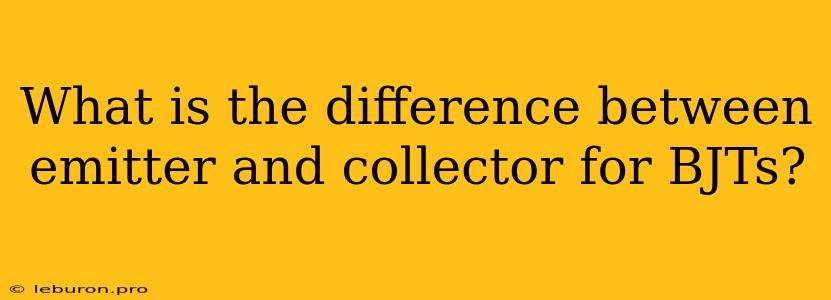Understanding the Difference Between Emitter and Collector in BJTs
Bipolar Junction Transistors (BJTs) are essential components in electronic circuits, serving as amplifiers and switches. At the heart of their operation lies the intricate interplay of three terminals: the emitter, base, and collector. While often grouped together, the emitter and collector play distinctly different roles within the BJT. This article will delve into the key distinctions between these terminals, explaining their functions, characteristics, and how they contribute to the overall behavior of the transistor.
The Emitter: The Source of Charge Carriers
The emitter, as its name suggests, is the source of charge carriers that flow through the transistor. In an NPN BJT, the emitter is heavily doped with n-type impurities, creating a high concentration of free electrons. In a PNP BJT, the emitter is heavily doped with p-type impurities, resulting in a high concentration of holes. These charge carriers are the fundamental actors in the transistor's current flow.
Key Characteristics of the Emitter:
- High doping concentration: This ensures a large number of free charge carriers are readily available for injection into the base.
- Thin and wide: The emitter region is intentionally designed to be thin and wide to facilitate efficient injection of charge carriers into the base.
- Forward-biased: The emitter-base junction is forward-biased during transistor operation, allowing for the injection of charge carriers from the emitter into the base.
The Collector: The Sink for Charge Carriers
The collector, on the other hand, acts as the sink for the charge carriers injected from the emitter. In an NPN BJT, the collector is doped with n-type impurities, while in a PNP BJT, it's doped with p-type impurities. This doping creates a region with the opposite polarity to the emitter, ensuring that the charge carriers are attracted to the collector.
Key Characteristics of the Collector:
- Moderately doped: Unlike the emitter, the collector has a moderate doping concentration.
- Wide and thick: The collector region is usually wider and thicker than the emitter, providing a larger area for collecting charge carriers.
- Reverse-biased: The collector-base junction is reverse-biased during transistor operation, creating a strong electric field that attracts the charge carriers from the base and draws them into the collector.
The Base: The Control Element
The base, sandwiched between the emitter and collector, plays a crucial role in controlling the flow of charge carriers between the two. The base is lightly doped compared to the emitter and collector, creating a narrow depletion region. This thin region is critical for the transistor's amplification capability.
How the Base Controls Charge Carriers:
The base acts as a gate, regulating the number of charge carriers that traverse from the emitter to the collector. By varying the base current, we can control the flow of charge carriers through the base region.
- Small base current: A small base current allows a limited number of charge carriers to pass through, resulting in a low collector current.
- Large base current: A larger base current permits more charge carriers to pass through, leading to a higher collector current.
The Difference Between Emitter and Collector in Action
The distinct roles of the emitter and collector become evident when considering the operation of a transistor.
Example: NPN BJT
- Emitter injection: Electrons are injected from the heavily doped emitter into the lightly doped base.
- Base control: A small base current controls the number of electrons that cross the base region.
- Collector attraction: The reverse-biased collector-base junction creates a strong electric field that draws the electrons from the base into the collector.
- Amplification: The small base current controls a much larger collector current, demonstrating the transistor's amplifying capability.
Conclusion: Emitter and Collector - A Dynamic Duo
The emitter and collector, though distinct in their functions, work together to create the fundamental operation of a BJT. The emitter provides the charge carriers, while the collector acts as their destination. The base, as the control element, determines the flow of these carriers, ultimately influencing the current gain and amplification capabilities of the transistor. Understanding the specific roles and characteristics of the emitter and collector is crucial for designing and analyzing electronic circuits that utilize BJTs, enabling the realization of a wide range of applications in amplification, switching, and signal processing.
